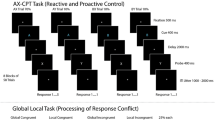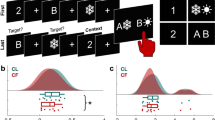Abstract
Advantageous effects of cognitive control are well-known, but cognitive control may also have adverse effects, for example when it suppresses the implicit processing of stimulus–response (S–R) bindings that could benefit task performance. Yet, the neurophysiological and functional neuroanatomical structures associated with adverse effects of cognitive control are poorly understood. We used an extreme group approach to compare individuals who exhibit adverse effects of cognitive control to individuals who do not by combining event-related potentials (ERPs), source localization, time–frequency analysis and network analysis methods. While neurophysiological correlates of cognitive control (i.e. N2, N450, theta power and theta-mediated neuronal network efficiency) and task-set updating (P3) both reflect control demands and implicit information processing, differences in the degree of adverse cognitive control effects are associated with two independent neural mechanisms: Individuals, who show adverse behavioral effects of cognitive control, show reduced small-world properties and thus reduced efficiency in theta-modulated networks when they fail to effectively process implicit information. In contrast to this, individuals who do not display adverse control effects show enhanced task-set updating mechanism when effectively processing implicit information, which is reflected by the P3 ERP component and associated with the temporo-parietal junction (TPJ, BA 40) and medial frontal gyrus (MFG; BA 8). These findings suggest that implicit S-R contingencies, which benefit response selection without cognitive control, are always ‘picked up’, but may fail to be integrated with task representations to guide response selection. This provides evidence for a neurophysiological and functional neuroanatomical “dual-process” account of adverse cognitive control effects.







Similar content being viewed by others
References
Achard S, Bullmore E (2007) Efficiency and cost of economical brain functional networks. PLoS Comput Biol 3:e17. https://doi.org/10.1371/journal.pcbi.0030017
Barack DL, Gold JI (2016) Temporal trade-offs in psychophysics. Curr Opin Neurobiol 37:121–125. https://doi.org/10.1016/j.conb.2016.01.015
Bassett DS, Bullmore E (2006) Small-world brain networks. The Neuroscientist 12:512–523. https://doi.org/10.1177/1073858406293182
Beck AT, Ward CH, Mendelson M et al (1961) An inventory for measuring depression. Arch Gen Psychiatry 4:561–571
Beldzik E, Domagalik A, Froncisz W, Marek T (2015) Dissociating EEG sources linked to stimulus and response evaluation in numerical Stroop task using Independent Component Analysis. Clin Neurophysiol 126:914–926
Beste C, Ness V, Lukas C et al (2012) Mechanisms mediating parallel action monitoring in fronto-striatal circuits. NeuroImage 62:137–146. https://doi.org/10.1016/j.neuroimage.2012.05.019
Beste C, Kneiphof J, Woitalla D (2015) Effects of fatigue on cognitive control in neurosarcoidosis. Eur Neuropsychopharmacol J Eur Coll Neuropsychopharmacol 25:522–530. https://doi.org/10.1016/j.euroneuro.2015.01.012
Binkofski F, Buccino G (2006) The role of ventral premotor cortex in action execution and action understanding. J Physiol-Paris 99:396–405
Bocanegra BR, Hommel B (2014) When Cognitive Control Is Not Adaptive. Psychol Sci 25:1249–1255. https://doi.org/10.1177/0956797614528522
Botvinick MM, Braver T (2015) Motivation and cognitive control: from behavior to neural mechanism. Annu Rev Psychol 66:83–113. https://doi.org/10.1146/annurev-psych-010814-015044
Botvinick MM, Cohen JD, Carter CS (2004) Conflict monitoring and anterior cingulate cortex: an update. Trends Cogn Sci 8:539–546. https://doi.org/10.1016/j.tics.2004.10.003
Bullmore E, Sporns O (2009) Complex brain networks: graph theoretical analysis of structural and functional systems. Nat Rev Neurosci 10:186–198. https://doi.org/10.1038/nrn2575
Buzsaki G, Draguhn A (2004) Neuronal oscillations in cortical networks. Science 304:1926–1929. https://doi.org/10.1126/science.1099745
Cavanagh JF, Frank MJ (2014) Frontal theta as a mechanism for cognitive control. Trends Cogn Sci 18:414–421. https://doi.org/10.1016/j.tics.2014.04.012
Cavanagh JF, Zambrano-Vazquez L, Allen JJB (2012) Theta lingua franca: a common mid-frontal substrate for action monitoring processes. Psychophysiology 49:220–238. https://doi.org/10.1111/j.1469-8986.2011.01293.x
Chmielewski WX, Beste C (2017) Testing interactive effects of automatic and conflict control processes during response inhibition—a system neurophysiological study. NeuroImage 146:1149–1156. https://doi.org/10.1016/j.neuroimage.2016.10.015
Chmielewski WX, Mückschel M, Dippel G, Beste C (2016) Concurrent information affects response inhibition processes via the modulation of theta oscillations in cognitive control networks. Brain Struct Funct 221:3949–3961. https://doi.org/10.1007/s00429-015-1137-1
Cohen MX (2014) A neural microcircuit for cognitive conflict detection and signaling. Trends Neurosci 37:480–490. https://doi.org/10.1016/j.tins.2014.06.004
Cui J-F, Wang Y, Shi H-S et al (2015) Effects of working memory load on uncertain decision-making: evidence from the Iowa Gambling Task. Front Psychol 6:162. https://doi.org/10.3389/fpsyg.2015.00162
De Blasio FM, Barry RJ (2013) Prestimulus delta and theta determinants of ERP responses in the Go/NoGo task. Int J Psychophysiol Off J Int Organ Psychophysiol 87:279–288. https://doi.org/10.1016/j.ijpsycho.2012.09.016
Demiralp T, Ademoglu A, Comerchero M, Polich J (2001a) Wavelet analysis of P3a and P3b. Brain Topogr 13:251–267
Demiralp T, Ademoglu A, Istefanopulos Y et al (2001b) Wavelet analysis of oddball P300. Int J Psychophysiol 39:221–227
DeWitt SJ, Ketcherside A, McQueeny TM et al (2015) The hyper-sentient addict: an exteroception model of addiction. Am J Drug Alcohol Abuse 41:374–381
Diamond A (2013) Executive functions. Annu Rev Psychol 64:135–168. https://doi.org/10.1146/annurev-psych-113011-143750
Dippel G, Beste C (2015) A causal role of the right inferior frontal cortex in implementing strategies for multi-component behaviour. Nat Commun 6:6587. https://doi.org/10.1038/ncomms7587
Dippel G, Chmielewski W, Mückschel M, Beste C (2016) Response mode-dependent differences in neurofunctional networks during response inhibition: an EEG-beamforming study. Brain Struct Funct 221:4091–4101. https://doi.org/10.1007/s00429-015-1148-y
Domenech P, Koechlin E (2015) Executive control and decision-making in the prefrontal cortex. Curr Opin Behav Sci 1:101–106. https://doi.org/10.1016/j.cobeha.2014.10.007
Doya K (2008) Modulators of decision making. Nat Neurosci 11:410–416. https://doi.org/10.1038/nn2077
Duncan J (2010) The multiple-demand (MD) system of the primate brain: mental programs for intelligent behaviour. Trends Cogn Sci 14:172–179
Fiebach CJ, Schubotz RI (2006) Dynamic anticipatory processing of hierarchical sequential events: a common role for Broca’s area and ventral premotor cortex across domains? Cortex 42:499–502
Geng JJ, Vossel S (2013) Re-evaluating the role of TPJ in attentional control: contextual updating? Neurosci Biobehav Rev 37:2608–2620. https://doi.org/10.1016/j.neubiorev.2013.08.010
Gohil K, Bluschke A, Roessner V et al (2017) ADHD patients fail to maintain task goals in face of subliminally and consciously induced cognitive conflicts. Psychol Med 1–13. https://doi.org/10.1017/S0033291717000216
Goschke T, Bolte A (2014) Emotional modulation of control dilemmas: The role of positive affect, reward, and dopamine in cognitive stability and flexibility. Neuropsychologia 62:403–423. https://doi.org/10.1016/j.neuropsychologia.2014.07.015
Gruber O, Goschke T (2004) Executive control emerging from dynamic interactions between brain systems mediating language, working memory and attentional processes. Acta Psychol (Amst) 115:105–121. https://doi.org/10.1016/j.actpsy.2003.12.003
Harper J, Malone SM, Bernat EM (2014) Theta and delta band activity explain N2 and P3 ERP component activity in a go/no-go task. Clin Neurophysiol Off J Int Fed Clin Neurophysiol 125:124–132. https://doi.org/10.1016/j.clinph.2013.06.025
Hoffmann S, Labrenz F, Themann M et al (2014) Crosslinking EEG time-frequency decomposition and fMRI in error monitoring. Brain Struct Funct 219:595–605. https://doi.org/10.1007/s00429-013-0521-y
Janssen TWP, Heslenfeld DJ, van Mourik R et al (2015) Alterations in the ventral attention network during the stop-signal task in children with ADHD: an event-related potential source imaging study. J Atten Disord. https://doi.org/10.1177/1087054715580847
Joyce AW (2016) Implicit working memory: implications for assessment and treatment. Appl Neuropsychol Child 5:223–234. https://doi.org/10.1080/21622965.2016.1167497
Keil A, Debener S, Gratton G et al (2014) Committee report: publication guidelines and recommendations for studies using electroencephalography and magnetoencephalography. Psychophysiology 51:1–21. https://doi.org/10.1111/psyp.12147
Koechlin E (2016) Prefrontal executive function and adaptive behavior in complex environments. Curr Opin Neurobiol 37:1–6. https://doi.org/10.1016/j.conb.2015.11.004
Koechlin E, Jubault T (2006) Broca’s area and the hierarchical organization of human behavior. Neuron 50:963–974
Larson MJ, Clayson PE, Clawson A (2014) Making sense of all the conflict: a theoretical review and critique of conflict-related ERPs. Int J Psychophysiol 93:283–297. https://doi.org/10.1016/j.ijpsycho.2014.06.007
Marco-Pallarés J, Grau C, Ruffini G (2005) Combined ICA-LORETA analysis of mismatch negativity. NeuroImage 25:471–477. https://doi.org/10.1016/j.neuroimage.2004.11.028
Miller EK (2000) The prefontral cortex and cognitive control. Nat Rev Neurosci 1:59–65. https://doi.org/10.1038/35036228
Miller EK, Cohen JD (2001) An integrative theory of prefrontal cortex function. Annu Rev Neurosci 24:167–202. https://doi.org/10.1146/annurev.neuro.24.1.167
Miyake A, Friedman NP, Emerson MJ et al (2000) The unity and diversity of executive functions and their contributions to complex “Frontal Lobe” tasks: a latent variable analysis. Cognit Psychol 41:49–100. https://doi.org/10.1006/cogp.1999.0734
Moeller SJ, Goldstein RZ (2014) Impaired self-awareness in human addiction: deficient attribution of personal relevance. Trends Cogn Sci 18:635–641
Mückschel M, Stock A-K, Beste C (2013) Psychophysiological mechanisms of interindividual differences in goal activation modes during action cascading. Cereb Cortex 24:2120–2129
Mückschel M, Stock A-K, Dippel G et al (2016) Interacting sources of interference during sensorimotor integration processes. NeuroImage 125:342–349. https://doi.org/10.1016/j.neuroimage.2015.09.075
Nolte G, Bai O, Wheaton L et al (2004) Identifying true brain interaction from EEG data using the imaginary part of coherency. Clin Neurophysiol 115:2292–2307. https://doi.org/10.1016/j.clinph.2004.04.029
Nunez PL, Pilgreen KL (1991) The spline-Laplacian in clinical neurophysiology: a method to improve EEG spatial resolution. J Clin Neurophysiol Off Publ Am Electroencephalogr Soc 8:397–413
Ochsner K, Gross J (2005) The cognitive control of emotion. Trends Cogn Sci 9:242–249. https://doi.org/10.1016/j.tics.2005.03.010
Olivers CNL, Nieuwenhuis S (2005) The beneficial effect of concurrent task-irrelevant mental activity on temporal attention. Psychol Sci 16:265–269. https://doi.org/10.1111/j.0956-7976.2005.01526.x
Pascual-Marqui RD (2002) Standardized low-resolution brain electromagnetic tomography (sLORETA): technical details. Methods Find Exp Clin Pharmacol 24(Suppl D):5–12
Perrin F, Pernier J, Bertrand O, Echallier JF (1989) Spherical splines for scalp potential and current density mapping. Electroencephalogr Clin Neurophysiol 72:184–187
Petruo VA, Stock A-K, Münchau A, Beste C (2016) A systems neurophysiology approach to voluntary event coding. NeuroImage 135:324–332. https://doi.org/10.1016/j.neuroimage.2016.05.007
Polich J (2007) Updating P300: an integrative theory of P3a and P3b. Clin Neurophysiol Off J Int Fed Clin Neurophysiol 118:2128–2148. https://doi.org/10.1016/j.clinph.2007.04.019
Quetscher C, Yildiz A, Dharmadhikari S et al (2015) Striatal GABA-MRS predicts response inhibition performance and its cortical electrophysiological correlates. Brain Struct Funct 220:3555–3564. https://doi.org/10.1007/s00429-014-0873-y
Rubinov M, Sporns O (2010) Complex network measures of brain connectivity: uses and interpretations. NeuroImage 52:1059–1069. https://doi.org/10.1016/j.neuroimage.2009.10.003
Salvador R, Suckling J, Coleman MR et al (2005) Neurophysiological architecture of functional magnetic resonance images of human brain. Cereb Cortex 15:1332–1342. https://doi.org/10.1093/cercor/bhi016
Scherbaum S, Dshemuchadse M, Ruge H, Goschke T (2012) Dynamic goal states: adjusting cognitive control without conflict monitoring. Neuroimage 63:126–136
Sekihara K, Sahani M, Nagarajan SS (2005) Localization bias and spatial resolution of adaptive and non-adaptive spatial filters for MEG source reconstruction. NeuroImage 25:1056–1067. https://doi.org/10.1016/j.neuroimage.2004.11.051
Stock A-K, Steenbergen L, Colzato L, Beste C (2016) The system neurophysiological basis of non-adaptive cognitive control: Inhibition of implicit learning mediated by right prefrontal regions: Neurophysiology of Non-Adaptive Control. Hum Brain Mapp 37:4511–4522. https://doi.org/10.1002/hbm.23325
Stock A-K, Gohil K, Beste C (2017) Blocking effects in non-conditioned goal-directed behaviour. Brain Struct Funct. https://doi.org/10.1007/s00429-017-1373-7
Taatgen NA, Juvina I, Schipper M et al (2009) Too much control can hurt: a threaded cognition model of the attentional blink. Cognit Psychol 59:1–29
Tallon-Baudry C, Bertrand O, Delpuech C, Pernier J (1997) Oscillatory γ-band (30–70 Hz) activity induced by a visual search task in humans. J Neurosci 17:722–734
Telesford QK, Joyce KE, Hayasaka S et al (2011) The ubiquity of small-world networks. Brain Connect 1:367–375. https://doi.org/10.1089/brain.2011.0038
Tenke CE, Kayser J (2012) Generator localization by current source density (CSD): implications of volume conduction and field closure at intracranial and scalp resolutions. Clin Neurophysiol Off J Int Fed Clin Neurophysiol 123:2328–2345. https://doi.org/10.1016/j.clinph.2012.06.005
Watts DJ, Strogatz SH (1998) Collective dynamics of “small-world” networks. Nature 393:440–442. https://doi.org/10.1038/30918
Wolff N, Zink N, Stock AK, Beste C (2017) On the relevance of the alpha frequency oscillation’s small-world network architecture for cognitive flexibility. Sci Rep 7:13910
Yordanova J, Kolev V (1998) Event-related alpha oscillations are functionally associated with P300 during information processing. Neuroreport 3159–3164
Yordanova J, Kolev V, Polich J (2001) P300 and alpha event-related desynchronization (ERD). Psychophysiology 38:143–152
Yordanova J, Falkenstein M, Hohnsbein J, Kolev V (2004) Parallel systems of error processing in the brain. NeuroImage 22:590–602. https://doi.org/10.1016/j.neuroimage.2004.01.040
Zhang R, Stock A-K, Fischer R, Beste C (2016) The system neurophysiological basis of backward inhibition. Brain Struct Funct 221:4575–4587
Acknowledgements
This work was supported by a Grant from the Deutsche Forschungsgemeinschaft (DFG) SFB 940 project B8.
Author information
Authors and Affiliations
Corresponding author
Electronic supplementary material
Below is the link to the electronic supplementary material.
Rights and permissions
About this article
Cite this article
Zink, N., Stock, AK., Colzato, L. et al. Evidence for a neural dual-process account for adverse effects of cognitive control. Brain Struct Funct 223, 3347–3363 (2018). https://doi.org/10.1007/s00429-018-1694-1
Received:
Accepted:
Published:
Issue Date:
DOI: https://doi.org/10.1007/s00429-018-1694-1




